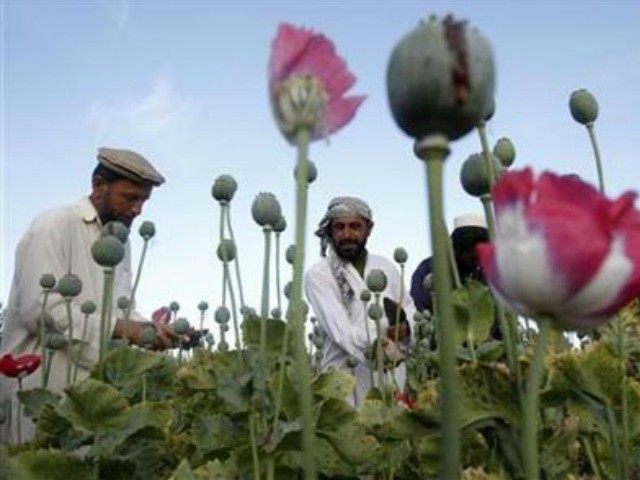Jihadists from the Islamic State (ISIS/ISIL) branch in Afghanistan have attacked Taliban militants in the northern part of the country over the lucrative opium trafficking business, reportedly revealed a spokesman for the governor of Jawzjan province where the clashes took place.
“Taliban and ISIS have been fighting in Jawzjan province resulting in lots of casualties on both sides,” Ioannis Koskinas, an Afghanistan expert from the New America think-tank, told Breitbart News. “Reportedly, the fight is largely over control of opium and control of other criminal activities, such as extortion and smuggling.”
Citing a spokesman for the governor of northern Afghanistan’s Jawzjan province, Afghan journalist Bilal Sarwary recently wrote on Twitter, “ISIS killed. On going [sic] fighting in at least 4 villages. 2sides fighting over extortions from opium&other harvests.”
ISIS killed. On going fighting in at least 4 villages. 2sides fighting over extortions from opium&other harvests." Spox Gov Jowzjan.
— BILAL SARWARY (@bsarwary) April 26, 2017
Pajhwok Afghan News learned from Mohammad Reza Ghafori, the governor’s spokesman, that the bloody clashes in the northern province “followed the kidnapping of three drug smugglers by Daesh [ISIS] loyalists in Dasht-i-Lali area of Qush Tapa district.”
The Afghan news outlet adds:
Rahmatullah Husher, the Darzab district’s administrative chief, said the three smugglers had arrived from western Herat and southern Helmand provinces to Dasht-i-Lali [in Jawzjan province] for a deal…with the Taliban.
But the smugglers were later kidnapped by Daesh along with a vehicle and weapons, the district chief said, citing it a reason behind the clashes.
The Taliban repeatedly asked Daesh to release the kidnappers, but their request was ignored, and then the Taliban decided to face Daesh.
Taliban-controlled Helmand province in southern Afghanistan, along the Pakistan border, is the top opium-producing region in the country, the United Nations has reported.
Breitbart News recently learned from various experts, including Koskinas from New America, that ISIS is likely involved in the lucrative opium business in Afghanistan despite the terrorist group’s claims to the contrary.
Despite the U.S. government spending more than $8.5 billion on counternarcotics efforts in Afghanistan, the country remains the world’s largest producer of opium and its heroin derivative.
ISIS and the Taliban have been fighting for turf and influence since the ISIS branch in the region, known as the Khorasan Province (ISIS-K), officially announced its presence in Afghanistan back in January 2015.
Taliban jihadists, which generate as much as 60 percent of their funding from harvesting and trafficking opium and its heroin derivative, remain Afghanistan’s most potent terrorists in manpower and territory.
The fight between the two jihadists groups in Jawzjan province is proof that ISIS-K is operating well beyond its eastern Afghanistan stronghold of Nangarhar province, located along the Pakistan border.
Suspected ISIS jihadists killed six International Committee of the Red Cross (ICRC) employees in the northern province back in February.
The Associated Press (AP) learned from the Jawzjan governor’s spokesman that ISIS seized two districts in the northern province from the Taliban.
“Fierce clashes between Taliban and Daesh (ISIS) gunmen left at least 91 fighters dead on both sides in northern Jawzjan province, local officials claimed on Wednesday,” reports Pajhwok Afghan News.
The governor’s spokesman revealed that the Taliban lost at least 76 of its terrorists, including commanders, while ISIS suffered 15 fatalities. At least 57 Taliban jihadists and 12 ISIS fighters were also wounded.
Jawzjan province borders the former Soviet republic of Turkmenistan, considered an important stop on the ancient trade route known as the Silk Road.
Although experts told Breitbart News that ISIS might be involved in the lucrative opium business in Afghanistan, a spokesperson for the U.S./NATO military mission in Afghanistan mission would neither confirm nor deny whether the ISIS-K is involved in the illegal opium trade.
“We can’t share information at this time regarding evidence of ISIS-K trafficking in opium,” U.S. Navy Lt. Lauren Sucher told Breitbart News.
Capt. Bill Salvin, another spokesman for the U.S./NATO mission in Afghanistan, did acknowledge the existence of opium crops in the ISIS-held district of Achin in Nangarhar where the U.S. military recently dropped the GBU-43/B Massive Ordnance Air Blast (MOAB), known as the “mother of all bombs.”
Experts such as Dr. Vanda Felbab-Brown from the Brookings Institution insist that ISIS is not involved in the opium trade.
Unlike the Taliban, ISIS in Afghanistan “has prohibited opium poppy cultivation both on grounds of ideological purity the strategic goal of ensuring that the only employment available to local men is as IS [Islamic State] foot soldiers,” Felbab-Brown told lawmakers on Thursday.
Both the Taliban and ISIS are fighting to overthrow the U.S.-backed government of Afghanistan. Nevertheless, some U.S. and Afghan officials have suggested the two groups have worked together at least once.
The majority of ISIS-K fighters are disgruntled Pakistani and Afghan Taliban jihadists.
Jawzjan province has “witnessed growing activities by the loyalists of the Islamic State of Iraq and Syria (ISIS) terrorist group who are mainly operating in Darzab district,” reports Khaama Press (KP).
According to the U.S. military, ISIS-K has been dramatically degraded from a peak of 3,000 jihadists to about 700 now.

COMMENTS
Please let us know if you're having issues with commenting.